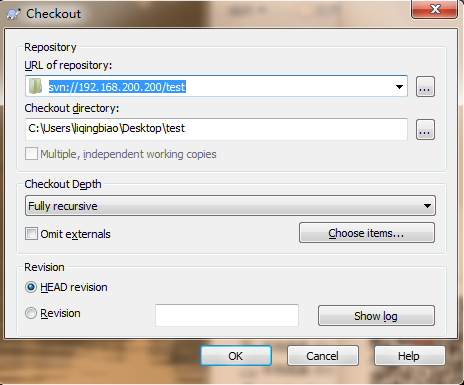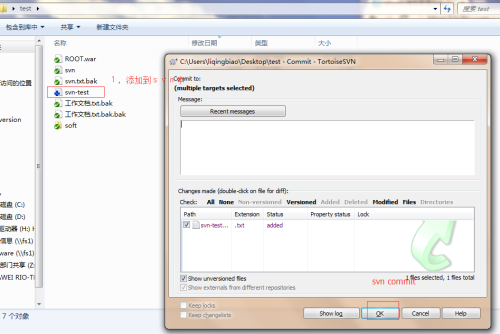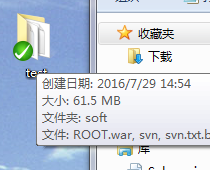https://www.cnblogs.com/weifeng1463/p/7593729.html
CentOS下搭建SVN服务器
一,介绍SVN
SVN是Subversion的简称,是一个开放源代码的版本控制系统,相较于RCS、CVS,它采用了分支管理系统,它的设计目标就是取代CVS。互联网上很多版本控制服务已从CVS迁移到Subversion。说得简单一点SVN就是用于多个人共同开发同一个项目,共用资源的目的。 ----百度百科
二,安装SV
官网下载: http://subversion.apache.org/packages.html
SVN客户端TortoiseSVN :https://tortoisesvn.net/downloads.html
1,yum install subversion安装
|
1
|
[root@localhost conf]# yum install subversion |
2,新建一个目录用于存储SVN目录
|
1
|
[root@localhost]mkdir /svn |
3,新建一个测试仓库
|
1
2
3
4
5
6
7
8
9
|
[root@localhost svn]# svnadmin create /svn/test/[root@localhost svn]# ll /svn/test/total 24drwxr-xr-x. 2 root root 4096 Jul 28 18:12 confdrwxr-sr-x. 6 root root 4096 Jul 28 18:12 db-r--r--r--. 1 root root 2 Jul 28 18:12 formatdrwxr-xr-x. 2 root root 4096 Jul 28 18:12 hooksdrwxr-xr-x. 2 root root 4096 Jul 28 18:12 locks-rw-r--r--. 1 root root 229 Jul 28 18:12 README.txt |
以下关于目录的说明:
hooks目录:放置hook脚步文件的目录
locks目录:用来放置subversion的db锁文件和db_logs锁文件的目录,用来追踪存取文件库的客户端
format目录:是一个文本文件,里边只放了一个整数,表示当前文件库配置的版本号
conf目录:是这个仓库配置文件(仓库用户访问账户,权限)
4,配置SVN服务的配置文件svnserver.conf:
|
1
2
3
4
5
6
7
8
9
10
11
12
13
14
15
16
17
18
19
20
21
22
23
24
25
26
27
28
29
30
31
32
33
34
35
36
37
38
39
40
41
42
43
44
45
|
[root@localhost conf]# vim svnserve.conf ### This file controls the configuration of the svnserve daemon, if you### use it to allow access to this repository. (If you only allow### access through http: and/or file: URLs, then this file is### irrelevant.)### Visit http://subversion.tigris.org/ for more information.[general]### These options control access to the repository for unauthenticated### and authenticated users. Valid values are "write", "read",### and "none". The sample settings below are the defaults.anon-access = read ##注意前边不要有空格,要顶齐auth-access = write ##注意前边不要有空格,要顶齐### The password-db option controls the location of the password### database file. Unless you specify a path starting with a /,### the file's location is relative to the directory containing### this configuration file.### If SASL is enabled (see below), this file will NOT be used.### Uncomment the line below to use the default password file.password-db = passwd ##注意前边不要有空格,要顶齐### The authz-db option controls the location of the authorization### rules for path-based access control. Unless you specify a path### starting with a /, the file's location is relative to the the### directory containing this file. If you don't specify an### authz-db, no path-based access control is done.### Uncomment the line below to use the default authorization file.authz-db = authz ### This option specifies the authentication realm of the repository.### If two repositories have the same authentication realm, they should### have the same password database, and vice versa. The default realm### is repository's uuid.realm = This is My First Test Repository ##这个是提示信息[sasl]### This option specifies whether you want to use the Cyrus SASL### library for authentication. Default is false.### This section will be ignored if svnserve is not built with Cyrus### SASL support; to check, run 'svnserve --version' and look for a line### reading 'Cyrus SASL authentication is available.'# use-sasl = true### These options specify the desired strength of the security layer### that you want SASL to provide. 0 means no encryption, 1 means### integrity-checking only, values larger than 1 are correlated### to the effective key length for encryption (e.g. 128 means 128-bit### encryption). The values below are the defaults.# min-encryption = 0# max-encryption = 256 |
5,配置访问用户及密码
|
1
2
3
4
5
6
7
8
9
10
11
|
[root@localhost conf]# vim passwd ### This file is an example password file for svnserve.### Its format is similar to that of svnserve.conf. As shown in the### example below it contains one section labelled [users].### The name and password for each user follow, one account per line.[users]# harry = harryssecret# sally = sallyssecretlqb = lqb123456test1 = 123456test2 = 654321 |
6,配置新用户的授权文件
|
1
2
3
4
5
6
7
8
9
10
11
12
13
14
15
16
17
18
19
20
21
22
23
24
25
26
27
28
29
30
31
32
33
34
|
[root@localhost conf]# vim authz ### This file is an example authorization file for svnserve.### Its format is identical to that of mod_authz_svn authorization### files.### As shown below each section defines authorizations for the path and### (optional) repository specified by the section name.### The authorizations follow. An authorization line can refer to:### - a single user,### - a group of users defined in a special [groups] section,### - an alias defined in a special [aliases] section,### - all authenticated users, using the '$authenticated' token,### - only anonymous users, using the '$anonymous' token,### - anyone, using the '*' wildcard.###### A match can be inverted by prefixing the rule with '~'. Rules can### grant read ('r') access, read-write ('rw') access, or no access### ('').[aliases]# joe = /C=XZ/ST=Dessert/L=Snake City/O=Snake Oil, Ltd./OU=Research Institute/CN=Joe Average[groups]# harry_and_sally = harry,sally# harry_sally_and_joe = harry,sally,&joe# [/foo/bar]# harry = rw# &joe = r# * =# [repository:/baz/fuz]# @harry_and_sally = rw# * = radmin = lqb,test2user = test1[/svn/test/]@admin = rw @user = r |
备注:
admin = lqb,test2 创建admin组,组成员为:lqb,test2
user = test1 创建用户组,用户成员:test1
[test:/] 赋予根权限,为了便于管理和权限的控制,可以把权限细化到版本库中相应的目录
@admin = rw admin组有读写的权限
@user = r user组只有读的权限
*= 表示除了上面设置的权限用户组以外,其他所有用户都设置空权限,空权限表示禁止访问本目录,这很重要一定要加上。
备注:版本库的目录格式如下:
[<版本库>:/项目/目录]
@<用户组名> = 权限
<用户名> = 权限
其中[]內容有許多写法:
[/],表示根目录及其一下的路径,根目录是svnserver启动时指定好的,上述实例中我们指定为:/svn/svndata([/]=/svn/svndata).[/]就是表示对全部版本设置的权限
[test:/],表示对版本库test设置权限;
[test:/svnadmin],表示对版本库test中的svnadmin项目设置权限;
[test:/svnadmin/second],表示对版本库test中的svnadmin项目的目录设置权限;
权限的主体可以是用户组,用户或者*,用户组在前面要以@开头,*表示全部用户
权限分为:r ,w, rw和null ,null空表示没有任何权限。
auhtz配置文件中的每个参数,开头不能有空格,对于组要以@开头,用户不需要。
7,启动svn服务
|
1
|
[root@localhost conf]#svnserve -d -r /svn/ |
注意:更改svnserver.conf时需要重启SVN服务,更改authz,passwd文件时则不需要重启服务
二,通过客户端进行连接:
<一>,Windos客户端连接操作
1,使用windows的客户端来进行连接
2,在Linux使用如下命令行:
|
1
2
3
4
|
[root@localhost conf]# svn co svn://192.168.200.200/testA test/工作文档.txt.bakA test/softChecked out revision 2. |
如果失败的话,基本上可以断定authz文件的配置有问题,可以修改下:
|
1
2
3
4
5
6
|
admin = lqb,test2user = test1[/]@admin = rw @user = r * = ###表示除了上面设置的权限用户组以外,其他所有用户都设置空权限,空权限表示禁止访问本目录 |
3,check out后会在桌面创建一个文件夹,说明操作成功,接下来向该文件夹放文件,然后右键SVN commit,会看到文件在同步,如图一,二,三,四,五
图一
图二
图三
图四
4,同步完成之后,我们可以在本地查看是否同步到服务器中,右击桌面--->TortoiseSVN→Repo Browser即可查看,也可以先SVN Update更新一下,确保内容是最新的。
5,如果要删除文件,直接本地删除然后commit即可。
如果查看历史版本TortoiseSVN,右击文件夹-->TortoiseSVN-->Show log.而且可以查看文档发生了什么变化。
如果版本库地址发生了变化更换的步骤如下:右击文件夹-->TortoiseSVN-->Relocate修改地址确认commit即可
<二>,Linux客户端同步过程:
把linux做为SVN客户端,所以你操作的并不一定是SVN的服务器那台,以后如果说我要定时自动发布代码等等,这时候就要用到脚本了,所以接下来的也是很重要的首先安装SVN,步骤同上,在此就不在赘述。
1,同步文件,check out: svn co svn://192.168.1.202/sadoc /data/svndata/ --username=我的用户名 --password=我的密码
|
1
2
3
4
5
6
7
8
9
10
|
[root@localhost conf]# svn co svn://192.168.200.200/test /svn --username=lqb --password=lqb123456A /svn/svn.txt.bakA /svn/工作文档.txt.bak.bakA /svn/svn-test.txtA /svn/svn.txtA /svn/工作文档.txt.bakA /svn/ROOT.warA /svn/softA /svn/soft/ROOT.warChecked out revision 16. |
注意! 你的密码,对于认证域: <svn://23.110.85.249:3690> 68cfb7eb-c123-4643-8825-8a067020e3f4只能明文保存在磁盘上!
如果可能的话,请考虑配置你的系统,让 Subversion可以保存加密后的密码。请参阅文档以获得详细信息。
你可以通过在“/root/.subversion/servers”中设置选项“store-plaintext-passwords”为“yes”或“no”,来避免再次出现此警告。2,版本库内容更新
|
1
2
3
4
5
6
|
[root@localhost conf]# svn update svn://192.168.200.200/test /svn --username=lqb --password=lqb123456Skipped 'svn://192.168.200.200/test'At revision 16.Summary of conflicts: Skipped paths: 1[root@localhost conf]# |
3,查看svn中的数据
|
1
2
3
4
5
6
7
8
9
|
[root@localhost conf]# svn ls svn://192.168.200.200/test/ --username=lqb --password=lqb123456ROOT.warsoft/svn-test.txtsvn.txtsvn.txt.bak工作文档.txt.bak工作文档.txt.bak.bak[root@localhost conf]# |
4,本地数据commit数据到SVN中
|
1
2
3
4
5
6
7
8
9
|
[root@localhost svn]# vim 123.log"123.log" [New] 3L, 32C written [root@localhost svn]# svn add 123.log A 123.log[root@localhost svn]# svn ci -m "commit data"Adding 123.logSending svn.txtTransmitting file data ..Committed revision 17. |
-m [--message] ARG: 指定日志信息ARG 不添加-m参数会报错。
<三>,SVN目录树
一般比较规范的SVN它会有三个目录,分别为:
/svn/trunk: 主干
/svn/branch: 个人或团队开发的分支
/svn/tag: 标记版本,比如某个版本开发好了。
现在我要创建三个这样的目录,然后我要导入到版本库中去,这里会用到的是import命令
import:将未纳入版本控制的文件或目录树提交到版本库。要分清楚它和commit的区别,commit指的是把工作副本的修改提交到版本库。
|
1
2
3
4
5
6
7
|
[root@localhost svndata]# mkdir -p svn/{trunk,branch,tag}[root@localhost svndata]# svn import /svn/svn svn://192.168.200.200/test --username=lqb --password=lqb123456 -m "import" Adding /svn/svn/trunkAdding /svn/svn/tagAdding /svn/svn/branchCommitted revision 18.[root@localhost svndata]# |
把主干的东西拷到一个分支
|
1
2
|
[root@localhost svndata]# svn copy svn://192.168.200.200/test/trunk svn://192.168.200.200/test/branch/branch -m "create a branch" --username=lqb --password=lqb123456Committed revision 19. |
本文出自 “清风明月” 博客,请务必保留此出处http://liqingbiao.blog.51cto.com/3044896/1831236






